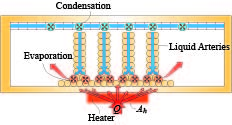High performance energy conversion systems/devices, i.e., nuclear power plants, electronic devices, solar-thermal energy collectors, and spacecraft (close to sun or reentry) dissipates significant amount of heat at given small surface area (high heat flux), and a failed thermal management results in deteriorated performance, reduced durability, and/or even broken-down systems/devices. A good solution to this is to employ phase-change (liquid to gas) latent heat for an effective and reliable cooling mechanism. Successful systems require optimal designs for continuous liquid feed and unhindered gas escape during heat dissipation, while keeping the thermal resistance low. My research addresses fundamental thermal-fluid science and engineering applied to the optimal nano/micro structures for high-performance, thermal energy transport systems outlined below.
1. Thin Evaporator and Liquid Artery Wicks
In conventional, phase-change cooling systems (heat pipe and vapor chamber), heat is consumed by liquid to gas phase change in the evaporator. The evaporated fluid is delivered to the condenser, and the condensed fluid (liquid) returns to the evaporator by the capillary pumping through permeable wicks for an effective coolant circulation. However, the cooling performance (the maximum cooling power and total thermal resistance) is limited either by a large thermal resistance from the thick wicks or large liquid pressure drop by the thin wicks, and the improved design requires optimal wick structures. My approach is to bring the modulated, wick structures, which are liquid artery (thick wick) for increased coolant feed, and very thin (monolayer) wick for decreased thermal resistance. For an optimal designing tool, I developed a heat pipe figure of merit, including liquid/thermal resistances and wick geometries, and it provides a successful design guide for the novel surface modulated wick structures. The wick is further optimized by a microstructured, thin evaporator wick (monolayer) with the vertical/lateral liquid arteries, and they achieve the double maximum cooling powers and only half of the thermal resistances, compared to the conventional designs, which led to an immediate and successful commercialization. In these designs, the role of the thin liquid film in the thin evaporator wick is crucial to the reduced thermal resistance, and my work successfully explains it using capillary meniscus recess dynamics and local thermal nonequilibrium liquid-solid-vapor models.

Relavant Publications
- Gi Suk Hwang, E. Fleming, B. Carne, S. Sharratt, Y. Nam, P. Dussinger, Y.S. Ju, M. Kaviany, “Multi-Artery Heat Pipe Spreader: Lateral Liquid Supply”, Int. J. Heat Mass Transfer, 54, 2334-2340, 2011.
- Gi Suk Hwang, Y. Nam, E. Fleming, P. Dussinger, Y.S. Ju, and M. Kaviany, “Multi-Artery Heat Pipe Spreader: Experiment”, Int. J. Heat Mass Transfer, 53, 2662–2669, 2010.
- D. H. Min, Gi Suk Hwang, and M. Kaviany, “Multi-Artery, Heat-Pipe Spreader”, Int. J. Heat Mass Transfer, 52, 629-635, 2009.
- Gi Suk Hwang, M. Kaviany et al., “Modulated Wick Heat Pipe”, Int. J. Heat Mass Transfer, 50, 1420-1434, 2007.
2. Micro Surface Structure Modifications for Two-Phase Flows
In liquid-rich systems (pool-boiling), gas escape rate is critical to the thermal transport limit, which is related to the hydrodynamic instability. This limit is important to avoid core rod damages from overheating when the nuclear power plant is in a severe accident. The hydrodynamic instability is related to the generated bubble size and surface density, which can be controlled by the micro/nano surface structures. My approach is to design novel micro-surface structures having periodic valleys to control the vapor morphology/density, and it advances the hydrodynamic limit by nearly two fold compared to a plain surface.
Relavant Publications
- D. H. Min, Gi Suk Hwang, Y. Usta, O.N. Cora, M. Koc, and M. Kaviany, “2-D and 3-D Modulated Porous Coatings for Enhanced Pool Boiling”, Int. J. Heat Mass Transfer, 52, 2607-2613, 2009.
- Gi Suk Hwang, M. Kaviany, “Critical Heat Flux in Thin, Uniform Particle Coatings”, Int. J. Heat Mass Transfer, 49, 844-849, 2006.
3. Thermoelectric cooler and power generator

